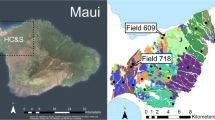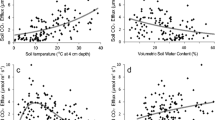Abstract
Soil-to-plant transfer of radionuclides can be related to plant evolutionary history (phylogeny). For some species and radionuclides the effect is significant enough to be useful in predicting Transfer Factors (TFs). Here a Residual Maximum Likelihood (REML)-based mixed model and a recent plant phylogeny are used to compile data on soil-to-plant transfer of radionuclides and to show how the phylogeny can be used to fill gaps in TFs. Using published data, generic means for TFs are used to anchor the data from REML modelling and hence predict TFs for important groups of plants. Radionuclides of Cs are used as an example. With a generic soil-to-plant TF of 0.07, TFs of 0.035 and 0.085 are predicted for monocot and eudicot gaps, respectively. Also demonstrated is how the known effects of soil conditions can be predicted across plant groups—predicted Cs TFs for gap-filling across all flowering plants are calculated for sandy loams with and without waterlogging. Predictions of TFs for Sr, Co, Cl and Ru are also given. Overall, the results show that general predictions of TFs based on phylogeny are possible—a significant contribution to gap filling for TFs.





Similar content being viewed by others
References
Abbazov MA, Dergunov ID, Mikulin RG (1978) Effect of soil properties on the accumulation of strontium-90 and cesium-137 in crops. Sov Soil Sci 10:52–56
Andersen AJ (1967) Investigations on the plant uptake of fission products from contaminated soils I. Influence of plant species and soil type on uptake of radioactive strontium and caesium. Report Risø170. Danish Atomic Energy Commission, Risø, Denmark
Angiosperm Phylogeny Group (2003) An update of the Angiosperm Phylogeny Group classification for the orders and families of flowering plants: APG II. Bot J Linn Soc 141:399–436
Angiosperm Phylogeny Group (2009) An update of the Angiosperm Phylogeny Group classification for the orders and families of flowering plants: APG III. Bot J Linn Soc 161:105–121
Bell JNB, Shaw G (2005) Ecological lessons from the chernobyl accident. Env Int 31:771–777
Beresford NA, Barnett CL, Brown J, Cheng J-J, Copplestone D, Filistovic V, Hosseini A, Howard BJ, Jones SR, Kamboj S, Kryshev A, Nedveckaite T, Olyslaegers G, Saxén R, Sazykina T, Vives i Batlle J, Vives-Lynch S, Yankovich T, Yu C (2008a) Inter-comparison of models to estimate radionuclide activity concentrations in non-human biota. Radiat Environ Biophys 47:491–514
Beresford NA, Barnett CL, Howard B, Scott WA, Brown JE, Copplestone D (2008b) Derivation of transfer parameters for use within the ERICA tool and the default concentration ratios for terrestrial biota. J Environ Radioact 99:1393–1407
Broadley MR, Willey NJ (1997) Differences in root uptake of radiocaesium by 30 plant taxa. Environ Pollut 97:11–17
Broadley MR, Willey NJ, Meade A (1999) The effect of taxonomic position on radiocaesium uptake by flowering plants. Environ Pollut 106:341–349
Broadley MR, Willey NJ, Wilkins J, Baker AJM, Mead A, White P (2001) Phylogenetic variation in heavy metal accumulation in angiosperms. New Phytol 152:9–27
Broadley MR, Bowen HC, Cotterill HL, Hammond JP, Meacham MC, Mead A, White PJ (2003) Variation in the shoot calcium content of angiosperms. J Exp Bot 54:1431–1446
Broadley MR, Bowen HC, Cotterill HI, Hammond JP, Meacham MC, Mead A, White PJ (2004) Phylogenetic variation in the shoot mineral concentration of angiosperms. J Exp Bot 55:321–336
Broadley MR, White PJ, Hammond JP, Zeklo I, Lux A (2007) Zinc in plants. New Phytol 173:677–702
Chase MW, Reveal JL (2009) A phylogenetic classification of the land plants to accompany APG III. Bot J Linn Soc 161:122–127
Copplestone D, Wood MD, Bielby S, Jones SR, Vives J, Beresford NA (2003) Habitats regulations for stage 3 assessments: radioactive substances authorisations. Environment Agency for England & Wales, HMSO. http://publications.environment-agency.gov.uk/pdf/SP3-101-SP1A-E-E.pdf
Cummings SL, Bankert L, Garrett AR, Regnier JF (1969) Cs-137 uptake by oat plants as related to the soil fixing capacity. Health Phys 17:145–148
Dobzhansky T (1973) Nothing in biology makes sense except in the light of evolution. Am Biol Teach 35:125–129
Doyle JJ (1998) Phylogenetic perspectives on nodulation: evolving views of plants and symbiotic bacteria. Trend Plant Sci 3:473–478
Dragović S, Janković Mandić LJ (2010) Transfer of radionuclides to ants, mosses and lichens in semi-natural ecosystems. Radiat Environ Biophys (this issue). doi:10.1007/s00411-010-0319-8
Evans EJ, Dekker AJ (1968) Comparative Cs-137 content of agricultural crops grown in a contaminated soil. Can J Soil Sci 48:45–53
Frissel MJ, Debb DL, Fathony M, Lin YM, Mollah AS, Ngo A, Othman I, Robinson WL, Skarlou-Alexiou V, Topcuoglu S, Twining JR, Uchida S, Wasserman MA (2002) Generic values for soil-to-plant transfer factors of radiocesium. J Environ Radioact 58:113–128
Garten CT, Paine D (1977) A multivariate analysis of factors affecting radiocaesium uptake by Sagittaria latifolia in coastal plain environments. J Environ Qual 6:78–82
Haston E, Richardson JE, Stevens PF, Chase MW, Harris DJ (2009) A linear sequence of the families in APG III. Bot J Linn Soc 161:128–131
He JS, Wang XP, Flynn DFB (2009) Taxonomic, phylogenetic, and environmental trade-offs between leaf productivity and persistence. Ecology 90:2779–2791
Higley KA (2010) Estimating transfer parameters in the absence of data. Radiat Environ Biophys (this issue). doi:10.1007/s00411-010-0326-9
Hodson MJ, White PJ, Mead A, Broadley MR (2005) Phylogenetic variation in the silicon composition of plants. Annal Bot 96:1027–1046
International Atomic Energy Agency (IAEA) (1994) Handbook of parameter values for the prediction of radionuclide transfer in temperate environments. Technical report series 364. IAEA, Vienna, Austria
International Atomic Energy Agency (IAEA) (2010) Handbook of parameter values for the prediction of radionuclide transfer in terrestrial and freshwater environments. Technical reports series, 472. IAEA, Vienna, Austria
Jensen S, Broadley MR, Robbrecht E, Smets E (2002) Aluminum hyperaccumulation in angiosperms: a review of its phylogenetic significance. Bot Rev 68:235–269
Kerkhoff AJ, Fagan WF, Elser JJ, Enquist BJ (2006) Phylogenetic and growth form variation in the scaling of nitrogen and phosphorus in the seed plants. Amer Nat 168:103–122
Khan MA, Ansari R, Ali H (2009) Panicum turgidum, a potentially sustainable cattle feed alternative to maize for saline areas. Agric Ecosys Env 129:542–546
Lesk AM (2007) Introduction to genomics. Oxford University Press, Oxford
Montargès-Pelletier E, Chardot V, Echevarria G, Michot LJ, Bauer A, Morel J-L (2008) Identification of nickel chelators in three hyperaccumulating plants: an X-ray spectroscopic study. Phytochemistry 69:1695–1709
Nisbet AF, Woodman RF (2000) Soil-to-plant transfer factors for radiocaesium and radiostrontium in agricultural systems. Health Phys 78:279–288
Papastefanou C, Manolopoulou M, Ioannidou M, Zahaiadou K, Stoulos S, Charalambous S (1989) Time-dependent radioacitive concentrations of fallout following the chernobyl reactor accident. Sci Tot Env 84:283–289
Patterson HD, Thompson R (1971) Recovery of inter-block information when block sizes are unequal. Biometrika 58:545–554
Prister BP, Perepelyatnikov GP, Perepelatnikova LV (1993) Countermeasures used in the Ukraine to produce forage and animal food products with radionuclide levels below intervention limits after chernobyl accident. Sci Tot Env 137:183–198
Quinn GP, Keough MJ (2002) Experimental design and data analysis for biologists. Cambridge University Press, Cambridge, UK
Sheppard MI, Sheppard SC, Sanipelli BL (2005) Recommended biosphere model values for uranium. Report No: 06819-REP-01200-10088-R00. Ontario Power Generation, Toronto, Ontario, Canada
Simpson MG (2006) Plant systematics. Elsevier Academic Press, London
Soltis PS, Soltis DE, Chase MW (1999) Angiosperm phylogeny inferred from multiple genes as a research tool for comparative biology. Nature 402:402–404
Tagami K, Uchida S (2010) Can elemental composition of crop leaves be used to estimate radionuclide transfer to tree leaves? Radiat Environ Biophys (this issue). doi:10.1007/s00411-010-0316-y
Thompson R, Welham SJ (2001) REML analysis of mixed models. In: Payne RW (ed) The guide to genstat-part 2. Statistics. VSN International, Oxford
Uchida S, Tagami K, Shang ZR, Choi YH (2009) Uptake of radionuclides and stable elements from paddy soil to rice: a review. J Environ Radioact 100:739–745
Vandenhove H, Olyslaegers G, Sanzharova N, Shubina O, Reed E, Shang Z, Velasco H (2009) Proposal for new best estimates of the soil-to-plant transfer factor of U, Th, Ra, Pb and Po. J Environ Radioact 100:721–732
Watanabe T, Broadley MR, White PJ, Jansen S, White PJ, Takada J, Satake K, Takamatsu T, Tuah SJ, Osaki M (2007) Evolutionary control of leaf element composition in plants. New Phytol 174:516–523
White PJ, Broadley MR (2000) Mechanisms of caesium uptake by plants. New Phytol 147:241–256
Willey NJ, Fawcett K (2005a) A phylogenetic effect on strontium concentrations in angiosperms. Environ Exp Bot 57:258–269
Willey NJ, Fawcett K (2005b) Species selection for phytoremediation of 36Cl/35Cl using angiosperm phylogeny and inter-taxa differences in uptake. Int J Phytorem 7:295–306
Willey NJ, Fawcett K (2006) Inter-taxa differences in root uptake of 103/106Ru by plants. J Environ Radioac 86:227–240
Willey NJ, Martin MH (1997) A comparison of caesium uptake by six grass species of contrasting growth strategy. Envion Pollut 95:311–317
Willey NJ, Wilkins J (2006) An analysis of intertaxa differences in sulfur concentration in angiosperms. J Plant Nutr Soil Sci 169:717–727
Willey NJ, Wilkins J (2008) Phylogeny and growth strategy as predictors of differences in cobalt concentrations between plant species. Environ Sci Technol 42:2162–2167
Willey NJ, Tang S, Watt N (2005) Predicting inter-taxa differences in plant uptake of 134/137Cs. J Environ Qual 34:1478–1489
Xie QE, Yan XL, Liao XY, Li X (2009) The arsenic hyperaccumulator fern Pteris vittata L. Environ Sci Technol 43:8488–8495
Yasuda H, Uchida S, Muramatsu Y, Yoshida S (1995) Sorption of manganese, cobalt, zinc, strontium and cesium onto agricultural soils: statistical analysis on effects of soil properties. Water Air Soil Pollut 83:85–96
Zar JH (2009) Biostatistical analysis, 5th edn. Pearson, New Jersey
Zhu Y-G, Smolders E (2000) Plant uptake of radiocaesium: a review of mechanisms, regulation and application. J Exp Bot 151:1635–1645
Acknowledgments
The author would like to thank Andrew Mead of Warwick HRI, The University of Warwick, Wellesbourne, Warwick, UK who first wrote the Genstat programme and Hildegarde Vandenhove of Studiecentrum voor Kernenergie: Centre d’Étude de l’énergie Nucléaire (SCK: CEN), Boeretang, Mol, Belgium for the raw data for the U compilation.
Author information
Authors and Affiliations
Corresponding author
Additional information
This paper is based on a presentation made at the second meeting of the Wildlife Transfer Coefficient Handbook Working Group of the IAEA EMRAS II programme (held at the IAEA, Vienna, 22–24 July 2009).
Electronic supplementary material
Below is the link to the electronic supplementary material.
Appendix
Appendix
The Genstat program used here for re-analyzing previously published Cs data (Willey et al. 2005). For details see text.
-
1.
job ‘Analysis of Cs data—Neil W’
-
2.
unit [943]
-
3.
fact [lev = 35] study
-
4.
fact [lev = 273] taxon
-
5.
open ‘I:caesium data.prn’; ch = 2; fi = in
-
6.
skip [2] 1
-
7.
read [ch = 2] study, taxon, concent
-
8.
close ch = 2
-
9.
tabu [cl = study] concent; mean = mtab; var = vtab; nobs = ntab
-
10.
calc sdtab = sqrt(vtab)
-
11.
calc cvtab = sdtab * 100/mtab
-
12.
print ntab, mtab, vtab, sdtab, cvtab; dec = 0,4(4); fie = 6,4(13)
-
13.
calc lconcent = log(concent)
-
14.
vcomponents [fixed = taxon] random = study
-
15.
reml [print = model, components, Waldtests; method = fisher] lconcent
-
16.
vkeep terms = taxon; means = tmeans
-
17.
calc etmeans = exp(tmeans)
-
18.
print tmeans, etmeans
-
19.
vtable table = tmeans; variate = mconcent; class = !p(mtaxon)
-
20.
unit [273]
-
21.
fact genus, family, order, superorder, group, class
-
22.
open ‘I:caesium phylogeny.prn’; ch = 2; fi = in
-
23.
skip [2] 1
-
24.
read [ch = 2] genus, family, order, superorder, group, class; skip = 1,5(0)
-
25.
close ch = 2
-
26.
treat class/group/superorder/order/family/genus
-
27.
anov [fact = 5;fprob = yes] mconcent
-
28.
endjob
Rights and permissions
About this article
Cite this article
Willey, N.J. Phylogeny can be used to make useful predictions of soil-to-plant transfer factors for radionuclides. Radiat Environ Biophys 49, 613–623 (2010). https://doi.org/10.1007/s00411-010-0320-2
Received:
Accepted:
Published:
Issue Date:
DOI: https://doi.org/10.1007/s00411-010-0320-2




